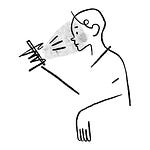It can help you say yes and no to the right things, find peace about your boundaries, & gain clarity about what matters most to you. In other words, it’s tremendously useful.
Tsh’s free weekly email, 5 Quick Things
Create your own Rule of Life — pay what you can!
This is The Good List — I’m Tsh Oxenreider.
This is an idea.
So, forgive me right off the bat, but I’m gonna read to you a short passage from my book At Home in the World, which was released in spring 2017 (hard to believe it’s already been 3 years!). At the end, after our family has returned from our year traveling around the world and living out of backpacks, I end our story talking about what I learned about home by essentially not having one that whole time. I say this at the top of chapter 22:
St. Benedict was a monk who led monks and nuns into a new way of living, into one of the earliest monastic traditions in church history. Scores of monks and nuns take vows of various sorts, but Benedict’s was the first to commit to staying put wherever they live, even if it gets hard, or even worse, boring. I found this helpful and encouraging as we settled back to post-travel life, relocating somewhere where I never thought I’d live again (that’s central Texas, if you’re curious).
My point here is that I was fascinated by how a monastic tradition could apply to my regular, ordinary, non-monk life. I’m a writer, wife, mom, and neighbor, and I found an old monastic tradition’s vows helpful. It led me to read a time-worn, widely-read document called St. Benedict’s Rule of Life, where he lays out the details of what it looks like for his community to, well, live in community.
It’s got deeper, spiritual stuff, like, “If there are artists in the community, they should practice their craft humbly... If someone is tempted by pride because of his great skill, or if he thinks too highly of his contribution to the community, he should be instructed to stop practicing his craft. ...After all, no art is more important than climbing the ladder of humility.” (I’m reading from a modern translation, by the way.) All the way to more practical housekeeping details, like, “By the door of the community, place a sensible older member who has basic secretarial skills and is glad to sit and welcome people. This member will need a room close to the entrance so that visitors will always find him there to answer them.”
I was fascinated by the detail and precision with which Benedict laid out not only the heart issues, the inner life of the community members, but also the practical how-tos regarding things like mealtimes, who’s in charge of what, and how they spend their time. In other words, he wrote out details about both the why and the how of their communal life.
I’d seen floating around a few examples of more modern-day rules of life, and I wanted to do that, too. But I knew I wanted mine a little different than Benedict’s, not least of which because I’m not a 6th century monk. I wanted the spirit of what he did, though — a practical write-up that detailed the why and how of what they did. Their rule of life became a sort of field guide to living well, according to their values.
I wanted my rule of life to be incredibly practical — I didn’t want to just write up a statement of beliefs, or a long confessional statement declaring what mattered to me… I wanted a go-to, living document that spelled out the things that mattered most to me, and the ethos of why they mattered. But I also didn’t want to do this randomly, lest I accidentally end up with a meaningless document of fluff that said little more than “live, laugh, love” on pretend barnwood.
I wanted something I’d actually use to help me make decisions because it reminded me of what actually mattered most to me. I wanted it to make sense to my life, I wanted it to make sense to our family as a whole, and I wanted it to be a living thing — a document I’d revisit on a regular basis and make little tweaks, since life changes frequently.
So, set to work figuring out how to do this well. I experimented on myself, using a question-asking process I’d learned in my life coaching training. I sorta-kinda experimented with a group of 15 of you guys, readers and listeners who support my work and who came out for a weekend here in my town last fall. Together, we went through a process of creating our rules of life, and these women gave me fantastic feedback on how I could make the process I was thinking of even better.
And in all actuality, this process was birthed from a class I created called Like Your Life, previously called Upstream Field Guide, if you’ve ever taken either one of those. Looking back with 6+ years of more wisdom and experience gained from creating that class, I can see how all along, what I was searching for was a way to create a useful, meaningful Rule of Life using the time-honored tradition practiced by millions of people for thousands of years.
Here I am today, talking to you about this, and I think I’ve landed on a practice that’s both really simple and gets right to the heart issue of what a good Rule of Life does. It’s a 3-step contemplation process that’s simple enough to revisit every few months or annually, yet it’s unfluffy enough to cut through the Christian-esey clutter and get to what actually matters.
The first step involves imagining how you’re best flourishing three years from now. The second step helps you uncover the most important rhythms in your life that affect you the most — naming your why, in other words, and the third step helps you craft your Rule of Life, getting down to the how-tos of how you do the things that matter to you.
And I’ve come to realize there are really good reasons why each of those steps are important, because it breaks all this down into only the stuff that matters to you. It reminds me a little of what my colleague and one of my favorite newsletter writers, Amy Lynn Andrews said when she was asked how she makes decisions about what to work on. Her friend asked her, “When you’re streamlining and look at all you’re doing, how do you decide what’s fluff?" Amy answered, "I don’t look at all I’m doing and pick out the fluff. I assume it’s all fluff and pick out what’s worth doing." That’s what creating a Rule of Life does — it helps you name only that which you believe is worth doing.
My favorite definition of a Rule of Life is this: it's simply a commitment to live your life in a particular way. Once it’s written out, it becomes a tool to help you make decisions and choices to best order your days. It’s like what Annie Dillard says: “How we spend our days is, of course, how we spend our lives.”
If you’re interested in writing your own Rule of Life, I’ve got a little something for you. I created a super-short, self-paced workshop you can use again and again in your life when you want to first create your Rule of Life, then revisit it and make tweaks as your life ebbs and flows. I made it audio, because that’s what I like best and I like how you can take audio with you, listening as you go on a walk or run errands or take to a coffee shop. I’m also providing a transcript of everything I say in this short, 4-part audio workshop for those of you who’d rather read all this. It also comes with a downloadable journaling guide you can print and use to your heart’s content, or you can just use your own personal journal with the questions provided.
And right now, I’m giving this to you at a pay-what-you-can rate. Yep, I want you to have this workshop whether you can pay $1 or $50. I’m doing this for two reasons: one, because I still consider this workshop to be in beta mode, so by your signing up for this workshop early, I can continue to make it even better and better as time goes on, but more important, reason 2 is because of all our economic uncertainty right now. I know a lot of people have lost jobs or stable income, and if this is you, I’d never want you to think you couldn’t create a Rule of Life for yourself. In fact, if you’re in that boat this is a more crucial time than ever to create one for you and your family! This sort of living document help you see through the fog so you can make better decisions and find more peace about what curveballs life throws at you. And if you can afford to pay more, in order to help out those who can’t right now, or simply as a way to say thank you if my work has meant anything to you, you can, and you’d be helping out your fellow Good List listeners who could use it.
No matter what you can afford, if you’d like to create yourself a Rule of Life, I’d love to give you this workshop that explains my simple-but-sturdy 3-step process for writing my own Rule of Life. I also share with you my own current RoL, not to prescribe for you how yours should be, but to give you an example if one would be helpful.
I’ll link to how to you can sign up for this workshop in the show notes of this episode, or you can head straight to thegoodlistshow.com/rule. And if you ultimately find creating a Rule of Life helpful, I’d love to hear about it. Mine has most definitely helped me as I’ve made changes in my work, say yes and no to certain family decisions that would otherwise leave me indecisive, and feel much more at peace about setting up boundaries where they’re needed as well as letting down some others where I’ve needed the freedom to do so. In other words, my Rule of Life has been tremendously helpful. I hope you find that yours is helpful for you, too.
[VOICEMAIL]
Hi Tsh, it's Caroline TeSelle from Lemont, Illinois. One thing that my family has done during this quarantine is to find something fun to do together as a family. We have four teenagers who are usually into a variety of things this time of year, from running track to softball to musicals. This is normally our season of crazy, now it's just crazy for a different reason. We're all doing our part to be responsible citizens and stay home, but sometimes we, well, maybe I should say, I get caught up in all the things and just forget to have fun. Sometimes I'm too serious and then it just rubs off on my family. My quarantine idea has been to find fun things to do that our family doesn't normally do and now we can do them at home! So far, we've done a TikTok video together and we've done the whipped cream challenge, and let me just say I failed big time at the whipped cream challenge. We're making a list of fun things to do. I just wanted to let you know that's our quarantine idea. Stay home and have fun. Thanks, Tsh.
[VOICEMAIL ENDS]
Another reminder to head to thegoodlistshow.com/rule to find my Rule of Life workshop, a four-part audio series with a downloadable guidebook that you can pay-what-you-can for. I hope you find it useful, doable, and encouraging! And another little reminder that if you haven’t yet, to sign up for my free weekly email called 5 Quick Things, where I share 5 things I either created or loved from the week. Go to fivequickthings.email to sign up, and you’ll get the next weekly email that goes out on Friday mornings.
I’m on twitter @tsh and sometimes on IG @tshoxenreider, and you can also find a transcript and the show notes of this episode, and all episodes, at thegoodlistshow.com.
Leave me a voicemail or send me a voice recording to tell me one thing that’s currently on your Good List. Either leave a voicemail at (401) 684-GOOD or record your voice and email the voice file to hi@tshoxenreider.com, and we may feature it here on the show.
Thanks to Caroline TeSelle for sharing with us what’s on her Good List, as well as for her help. Music for the show is by Kevin MacLeod, and thanks, as always, to Kyle Oxenreider, as well as my furry intern, Ginny. I’m Tsh Oxenreider, and I’ll be back with you soon — thanks for listening to The Good List.










Create a Rule of Life